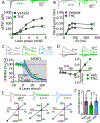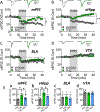Altered Corticolimbic Control of the Nucleus Accumbens by Long-term Δ9-Tetrahydrocannabinol Exposure
- PMID: 31543247
- PMCID: PMC7002212
- DOI: 10.1016/j.biopsych.2019.07.024
Altered Corticolimbic Control of the Nucleus Accumbens by Long-term Δ9-Tetrahydrocannabinol Exposure
Abstract
Background: The decriminalization and legalization of cannabis and the expansion of availability of medical cannabis in North America have led to an increase in cannabis use and the availability of high-potency strains. Cannabis potency is determined by the concentration of Δ9-tetrahydrocannabinol (Δ9-THC), a psychoactive constituent that activates cannabinoid CB1 and CB2 receptors. The use of high-potency cannabis is associated with cannabis use disorder and increased susceptibility to psychiatric illness. The nucleus accumbens (NAc) is part of a brain reward circuit affected by Δ9-THC through modulation of glutamate afferents arising from corticolimbic brain areas implicated in drug addiction and psychiatric disorders. Moreover, brain imaging studies show alterations in corticolimbic and NAc properties in human cannabis users.
Methods: Using in vitro electrophysiology and optogenetics, we examined how Δ9-THC alters corticolimbic input to the NAc in rats.
Results: We found that long-term exposure to Δ9-THC weakens prefrontal cortex glutamate input to the NAc shell and strengthens input from basolateral amygdala and ventral hippocampus. Further, whereas long-term exposure to Δ9-THC had no effect on net strength of glutamatergic input to NAc shell arising from midbrain dopamine neurons, it alters fundamental properties of these synapses.
Conclusions: Long-term exposure to Δ9-THC shifts control of the NAc shell from cortical to limbic input, likely contributing to cognitive and psychiatric dysfunction that is associated with cannabis use.
Keywords: Cannabinoid; Cannabis; Glutamate; Long-term depression; Marijuana; Medicinal marijuana; Synapse.
Copyright © 2019 Society of Biological Psychiatry. Published by Elsevier Inc. All rights reserved.
Conflict of interest statement
Disclosures
The authors report no biomedical financial interests or potential conflicts of interest.
Figures






Comment in
-
Cannabis Exposure Enhances Subcortical Control of Nucleus Accumbens Activity.Biol Psychiatry. 2020 Apr 1;87(7):592-594. doi: 10.1016/j.biopsych.2019.12.017. Biol Psychiatry. 2020. PMID: 32164914 No abstract available.
References
-
- Volkow Nora D, Morales M (2015): The Brain on Drugs: From Reward to Addiction. Cell. 162:712–725. - PubMed
-
- Mogenson GJ, Jones DL, Yim CY (1980): From motivation to action: functional interface between the limbic system and the motor system. Prog Neurobiol. 14:69–97. - PubMed
-
- Floresco SB (2015): The nucleus accumbens: an interface between cognition, emotion, and action. Annu Rev Psychol. 66:25–52. - PubMed
Publication types
MeSH terms
Substances
Grants and funding
LinkOut - more resources
Full Text Sources

